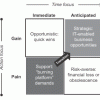Business Transformation Requires Transformational Leaders
Leadership and teaming skills are front and center in times of rapid change. Meet today’s constant disruption head on with expert guidance in leadership, business strategy, transformation, and innovation. Whether the disruption du jour is a digitally-driven upending of traditional business models, the pandemic-driven end to business as usual, or the change-driven challenge of staffing that meets your transformation plans—you’ll be prepared with cutting edge techniques and expert knowledge that enable strategic leadership.
Recently Published
Repetitive Innovation
Corporations that perform well over long periods of time have typically learned how to maximize the performance of their people. They recognize that it is people who make good or bad decisions or who may even avoid making decisions. They strive to create a business environment where employees feel valued and are supported by effective direction -- policies, procedures, standards of performance, guidelines, and tools -- for performing their work.
SaaS Not Just for SMBs
In his recent E-mail Advisor, titled "Software as a Service," Mike Rosen, the Director of Cutter Consortium's Enterprise Architecture Practice, does a great job of identifying some of the technological advancements which are making "SaaS" a viable solution for a variety of application requirements.
Microsoft CRM Going Live
Although everyone's known that it's been in the works for some time now, Microsoft last week finally revealed its plans for its upcoming on-demand CRM offering: "Microsoft Dynamics CRM Live."
One important fact to keep in mind when considering Microsoft's planned entry into the CRM software as a service (SaaS) market, is that it will not become generally available until sometime in mid-2007 for North America, with other locales to follow.
We think that this is a great time to focus on IT innovation because, as George Westerman, a research scientist with Massachusetts Institute of Technology's Center for Information Systems Research (CISR) points out in the May 2006 issue of Cutter Benchmark Review (CBR), innovation is alive and well in IT shops around the world, after years of tightening budgets and requests for keeping the lights on utilizing fewer and fewer resources.
An IT management idea that has not outlived its usefulness suggests how improved might be the performance of the IT organization were its members to undergo communications skills training. Put a router in a computer jock's hands and he's happy. Put him in front of a capital planning committee to justify the IT shop's 20% budget increase request and the result might be an audience recommendation to stick with routers.
How to Escape the "Burning Platform"
Most CIOs lead lives of quiet desperation, standing on a burning platform surrounded by a turbulent technological sea. But a few fortunate souls live in a different world -- one in which technology is seen by the organization as the "go-to" source for process improvement, as an enabler of business strategy, and even occasionally, as the means for achieving competitive advantage.
Five Rules to Minimize the Risk Associated with Project Rescue
Projects have problems. Most problems arise and are solved somewhat quickly; on some projects, however, the problems accumulate and are compounded to a point where they cannot be resolved successfully. These are sometimes called "troubled projects." These projects may limp along to the finish line. However, if the sponsor and management stakeholders perceive that the project cannot get to the finish line, a project rescue should be attempted.
Auditing Outsourcing Deals
Conducting audits of outsourcing deals is not something every organization focuses on. There are usually so many operational fires to be put out that review and compliance processes can easily be overlooked. Imagine, however, if you never reviewed your staff: they may become disinterested and unmotivated, and (worst of all) you may not know what they are actually doing! Outsourcing arrangements are no different.







